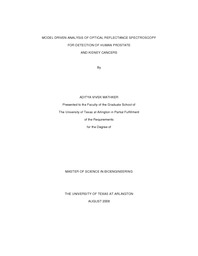
ATTENTION: The works hosted here are being migrated to a new repository that will consolidate resources, improve discoverability, and better show UTA's research impact on the global community. We will update authors as the migration progresses. Please see MavMatrix for more information.
Show simple item record
| dc.contributor.author | Mathker, Aditya Vivek | en_US |
| dc.date.accessioned | 2008-09-17T23:35:13Z | |
| dc.date.available | 2008-09-17T23:35:13Z | |
| dc.date.issued | 2008-09-17T23:35:13Z | |
| dc.date.submitted | August 2008 | en_US |
| dc.identifier.other | DISS-2245 | en_US |
| dc.identifier.uri | http://hdl.handle.net/10106/1130 | |
| dc.description.abstract | Renal cell carcinoma is one of the most common forms of kidney cancer originating from the renal tubule. During surgery, it is difficult for the surgeons to identify the cancer tissue from the normal tissue and also the benign tumor from malignant tumor. Moreover, prostate cancer is the leading cause of death amongst men in the United States. In this study, optical reflectance spectroscopy with short source-detector separation is used as a minimally invasive technique to differentiate normal tissues from tumor lesions and also to differentiate benign from malignant tissues in renal cell carcinoma. Clinical post-operative readings were obtained using the optical spectroscopic equipment. 23 cases of prostate cancer and 20 cases of kidney cancer were investigated to derive statistical differences. An analytical model, reported by Zonios and Dimou, provides a relationship, associating the measured reflectance with the reduced scattering coefficient (μs') and hemoglobin concentrations of the measured specimens. The model is fitted optimally to the experimental data in order to quantify respective parameters of the human renal and prostate tissues. After analyzing the clinical data, we obtained statistical differences in the oxy-hemoglobin (HbO) and deoxy-hemoglobin concentrations (Hb). The Student t-test was performed to show that p-values of 0.03 and 0.04 were obtained for the HbO and Hb components, respectively, while comparing the benign and malignant renal cell carcinomas. A significant differentiation was also observed between normal and cancerous tissues measured from the outside of the kidney [p-value = 0.04 (HbO), 1.36E-07 (Hb) & 0.03 (μs')]. For the prostate, the statistical difference between the readings taken on the normal and cancerous tissue was significant with a p-value of 0.02 for HbO, 0.03 for Hb and 4.07E-06 for μs'. These results have illustrated the feasibility of optical spectroscopy to be a viable technique for clinical detection of cancer. | en_US |
| dc.description.sponsorship | Liu, Hanli | en_US |
| dc.language.iso | EN | en_US |
| dc.publisher | Biomedical Engineering | en_US |
| dc.title | Model Driven Analysis Of Optical Reflectance Spectroscopy For Detection Of Human Prostate And Kidney Cancers | en_US |
| dc.type | M.S. | en_US |
| dc.contributor.committeeChair | Liu, Hanli | en_US |
| dc.degree.department | Biomedical Engineering | en_US |
| dc.degree.discipline | Biomedical Engineering | en_US |
| dc.degree.grantor | University of Texas at Arlington | en_US |
| dc.degree.level | masters | en_US |
| dc.degree.name | M.S. | en_US |
| dc.identifier.externalLink | https://www.uta.edu/ra/real/editprofile.php?onlyview=1&pid=28 | |
| dc.identifier.externalLinkDescription | Link to Research Profiles | |
Files in this item
- Name:
- umi-uta-2245.pdf
- Size:
- 1.063Mb
- Format:
- PDF
This item appears in the following Collection(s)
Show simple item record


